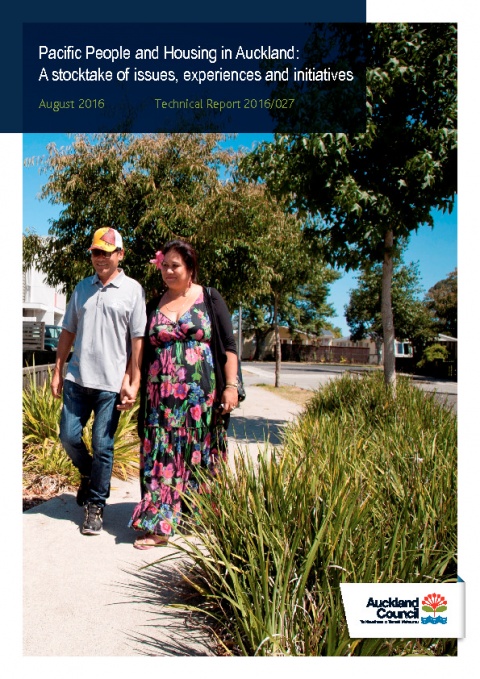Pacific people and housing in Auckland: a stocktake of issues, experiences and initiatives
Author:
Jennifer L R Joynt, Penelope Tuatagaloa, Penny LysnarSource:
Auckland Council Research and Evaluation Unit, RIMUPublication date:
2016Topics:
People ,HousingExecutive summary
Auckland is currently facing a housing crisis (Auckland Council, 2012a) characterised by a housing shortage, escalating prices for the purchase and rent of housing and a lack of affordable homes for both purchasers and renters. The effects are felt most acutely by those living on low incomes, including the Pacific population in Auckland.
This report draws from existing material to provide an understanding of the housing issues that many Pacific people are faced with, in New Zealand and Auckland in particular. The report is presented as a stocktake detailing both the impacts of housing on Pacific people and current programmes and policies which have been set in place to address these issues. It aims to inform housing policy development for Pacific people in Auckland.
Pacific people hail from many island countries and territories in the Pacific ocean, and comprise distinct populations with diverse political structures, socio-economic status, language and culture. While acknowledging the heterogeneous nature of Pacific people in Auckland, many people from different Pacific backgrounds experience similar disadvantages in New Zealand. As such, this report refers to both the broad category of Pacific people in Auckland and New Zealand as well as more specific Pacific groups where possible.
The Pacific population in Auckland is growing, and is anticipated to keep growing at a faster rate than most other ethnic groups. The majority of Pacific people in New Zealand live in the North Island and two out of every three people of Pacific ethnicity in New Zealand reside in Auckland (an increase of 9.6% or 17,007 people since 2006). Within Auckland the largest concentration of Pacific people is within a relatively contained area in south Auckland, including the Māngere-Ōtāhuhu, Ōtara-Papatoetoe and Manurewa local board areas. These areas are characterised by high levels of socio-economic deprivation, typified by lower than average educational, economical and health outcomes (Marriot and Sim, 2014).
The primary housing challenges that many Pacific people in Auckland face include higher than average rates of household crowding, lower than average home ownership rates, and less stability as a result of higher than average rates of renting. Pacific families in rental accommodation can be subjected to ‘rental churn’, whereby they regularly move house due to financial constraints or because their landlord changes the terms of the rental agreement. Rental churn has a particularly negative impact on young children who often have their education and social lives disrupted (Fu, Scott and Laing, 2015).
Since 2006, Pacific people in Auckland have had the lowest home ownership rates among all the main ethnic groups, with the largest reduction in home ownership occurring in the Tokelauan population (Statistics New Zealand, 2006 and 2013). As mentioned above, overcrowding is also a problem, with 45.3 per cent of Pacific people living in overcrowded properties (Goodyear and Fabian, 2014:80). Overcrowding can be partly attributed to cultural preferences for multigenerational living arrangements, financial insecurity, high birth rates and an obligation to accommodate visiting relatives and friends on a semi-permanent basis. Despite the social, cultural and economic factors that underlie the causes of overcrowding it is helpful to keep in mind the following observation by Baker, Goodyear, Barnard and Howden-Chapman (2012b:5) that ‘while perceptions and measures of crowding may be cultural and subjective, the effects of crowding are not.’
Global and nationwide factors that affect Pacific experiences of housing include low interest rates, the lack of supply of affordable housing in Auckland, the reduction in manufacturing jobs, as well as central government legislation and regulations such as the Residential Tenancies Act. In this report, experiences of housing by Pacific people are presented in their own words through quotes from individuals and families, from case study reports. These illustrate a complex regulatory environment, which many low-income individuals and families attempt to manoeuvre their way through on a daily basis.
A series of programmes and initiatives aimed at addressing housing supply, housing standards and affordability have been introduced by central government, local government and community organisations. The initiatives introduced at central government level tend to be broader in scope, whereas smaller scale community initiatives often have a more specific demographic as a focus for their programme. This report outlines housing initiatives and programmes introduced at a range of scales (from local to national), some of which are specific to Pacific people. While this report does not provide an in-depth evaluation of these initiatives and programmes, it does highlight potential opportunities for a closer study of initiatives as a potential next step.
Auckland Council technical report, TR2016/027
August 2016
